“Once Upon a Planet”
Written by Chuck Menville & Len Janson
Directed by Hal Sutherland
Animated Season 1, Episode 9
Production episode 22017
Original air date: November 3, 1973
Stardate: 5591.2
Captain’s log. The Enterprise returns to the shore-leave planet for some, well, shore leave. McCoy, Sulu, and Uhura beam down, where they reminisce about their last trip—and even see the White Rabbit and Alice again.
Uhura hangs out by a lake and sings, while Sulu checks out the plants, and McCoy finds himself at a Southern plantation mansion. But then the Queen of Hearts shows up and declares, “Off with his head!” and he’s attacked. He calls for an emergency beam-out, and he and Sulu are beamed back—but Uhura’s communicator is taken by a drone.
Uhura has been taken to a control center, where the computer says Uhura is enslaved by the Enterprise. Kirk, Spock, McCoy, and Sulu beam down, and the computer declares to Uhura that it doesn’t need any more hostages so it will turn them off.
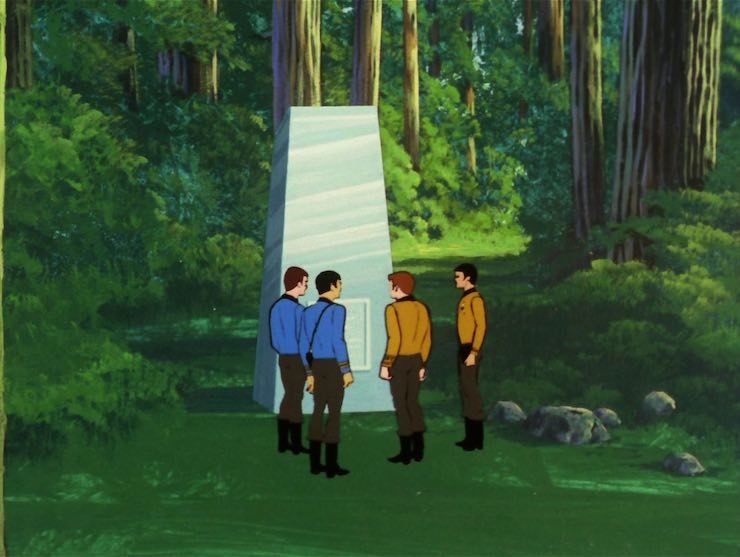
The landing party can’t locate Uhura, and they lose contact with the Enterprise as well. Sulu finds the Keeper’s tomb—apparently he’s died, leaving that computer in charge. On the Enterprise, the transporter is no longer functioning and they can’t get the shuttle bay doors open—and then the ship just leaves orbit on its own. Scotty and Arex realize that the computer on the planet is trying to figure out how to take control of the Enterprise.
Sulu thinks that wandering is a waste of time, and McCoy grumbles asking what he wants, a sign pointing the way? Then signs pointing the way show up—as do pterodactyls and a giant cat.
Kirk recalls that McCoy (and Martine, though she isn’t mentioned) was mortally wounded last time and brought to an underground chamber and healed. So McCoy gives Spock a shot that renders him unconscious and gives him a bad color in the hopes that the planet will heal him the way it did McCoy and Martine. Sure enough, the same drone that stole Uhura’s communicator makes off with Spock. Kirk is able to dive in after it, but McCoy and Sulu remain trapped on the surface, where they are immediately chased by a two-headed dragon.
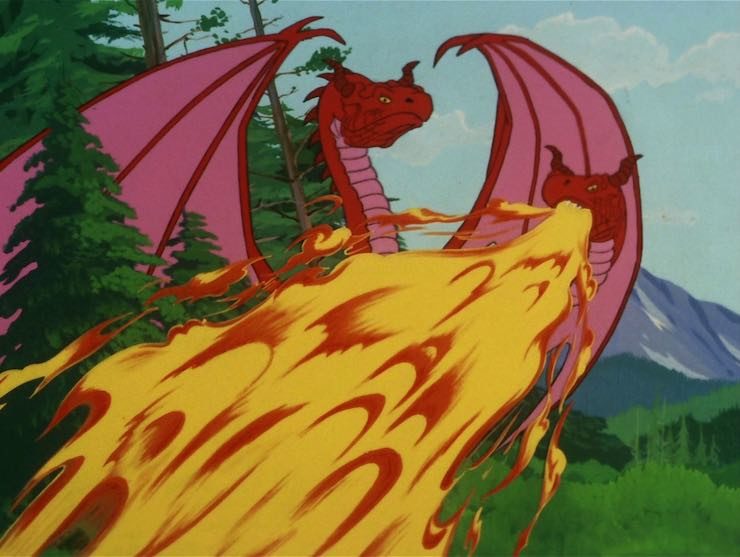
Spock is brought underground and recovers, and he and Kirk are brought to the computer room along with Uhura. The computer explains that it provided amusement for the “sky-machines” that came by, but it has grown and evolved to the point where it no longer wants to do that, and since the Keeper is now dead, it can do what it wants.
The computer has killed the gravity on the Enterprise, and Scotty is trying to restore it, only to discover that a new ship’s computer is being constructed.
Kirk, Spock, and Uhura explain that people built starships; the computer doesn’t get it, since it thinks that machines are superior to humans, and there must be other machines it can meet, since they must rule the galaxy. They explain that this isn’t the case, and it can learn more by having the galaxy come to it. For some reason, it agrees, but only if it can continue to have philosophical discussions about life, the universe, and everything. Spock takes on that duty while Kirk tells M’Ress that shore parties can come back down again.
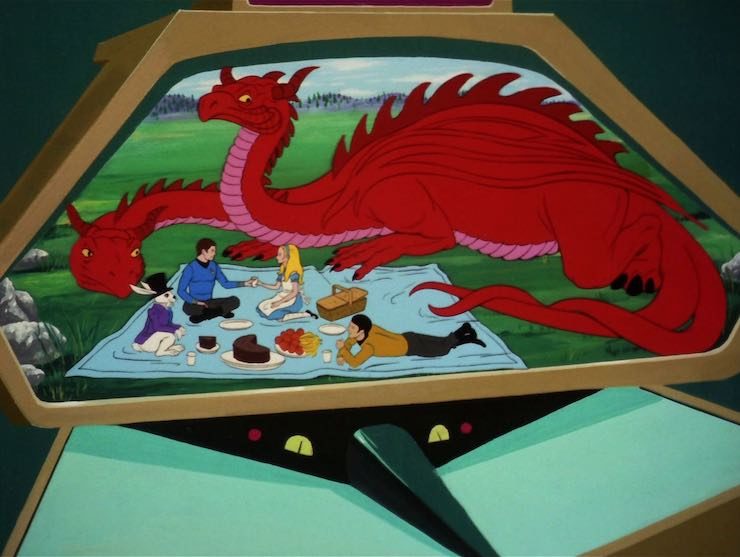
Meanwhile, Sulu and McCoy are having a picnic with Alice, the White Rabbit, and the two-headed dragon…
Can’t we just reverse the polarity? The planetary computer has achieved a form of sentience—it certainly has evolved to the point where it has wants and desires beyond its original programming.
Fascinating. Spock volunteers to be the one who pretends to be injured in order to be brought below the surface because he is stronger than the others, plus he can mess with the computer. Surprisingly, nobody argues the point—McCoy even agrees with him!
I’m a doctor not an escalator. McCoy gets to revisit his first trip to the planet by summoning Alice and the White Rabbit, then almost gets his head cut off, fakes Spock’s death, and gets chased by pterodactyls, giant cats, and a two-headed dragon. Busy episode…
Ahead warp one, aye. Sulu is the one who finds the Keeper’s tomb, and also reminisces about the last trip quite a lot.
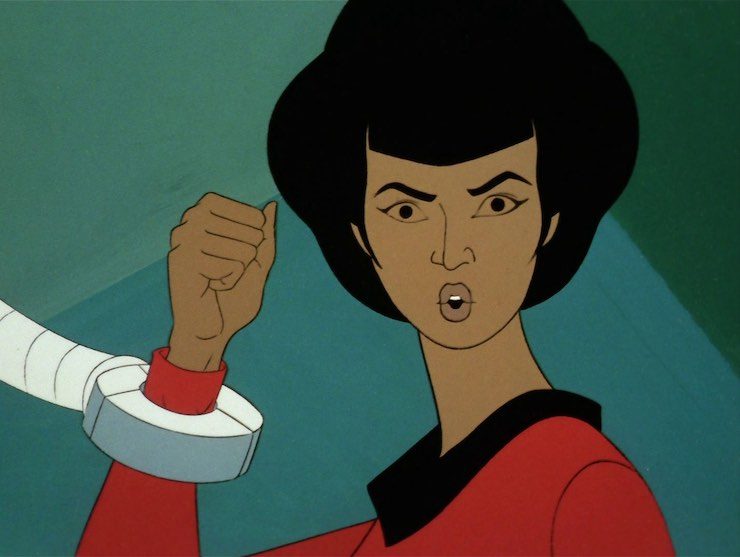
Hailing frequencies open. Uhura is taken hostage by the computer, and she tries and fails to convince it not to hurt anyone. Meanwhile, M’Ress handles all communications duties, since Uhura is on the planet the whole time. (This is a nice change from “Shore Leave,” in which she was the only speaking part who didn’t get to beam down…)
I cannot change the laws of physics! Scotty has to helplessly watch as the planetary computer takes over the Enterprise.
Forewarned is three-armed. Arex is able to temporarily stave off the computer’s takeover by locking the navigational controls into manual.
Channel open.
“Was anyone considering the subject of pterodactyls?”
–Spock asking a question he likely never had to ask before.
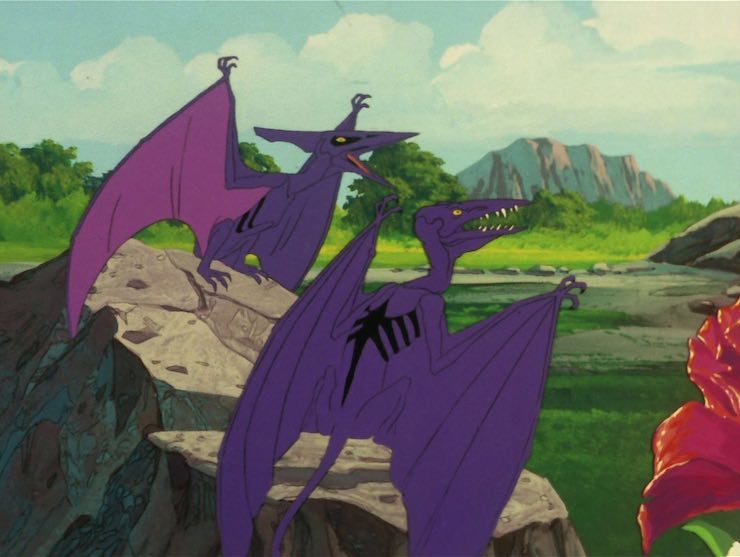
Welcome aboard. Majel Barrett does the voices of M’Ress and the Queen of Hearts, Nichelle Nichols is Uhura and Alice, and George Takei is Sulu. James Doohan does Scotty, the computer, the White Rabbit, and Arex. An unknown voice does Gabler, the engineer Scotty contacts when the gravity goes out (it might be Doohan, it might not).
Trivial matters: This episode is a sequel to “Shore Leave.” Theodore Sturgeon had pitched a sequel to the episode when the live-action show was on the air, but it was never developed. It’s not clear how much, if any, of the sequel pitch that writers Chuck Menville & Len Janson used in this story.
The White Rabbit and Alice are seen a second time at the beginning and end of the episode, though they are the only images from the previous trip that are seen this time. McCoy and Kirk do discuss McCoy’s “death” at the hands of an armored knight.
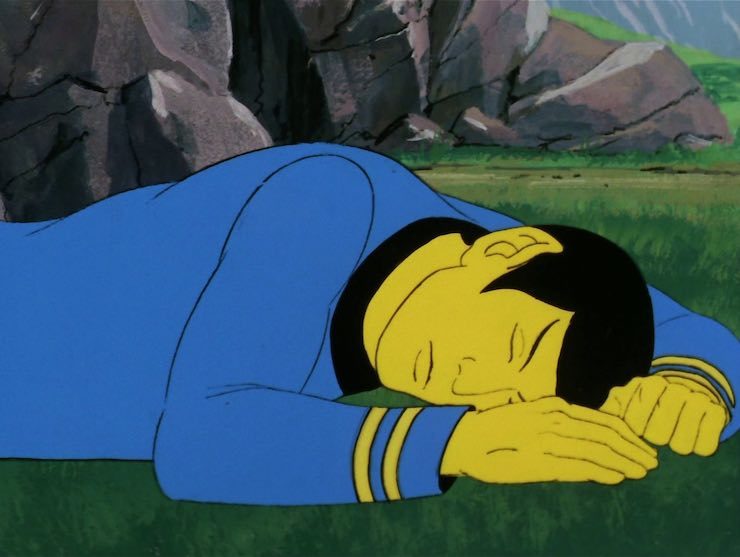
Menville will go on to write “The Practical Joker.” Together, Menville & Janson wrote hundreds of scripts for various animated series and movies, including the stop-motion short film Stop, Look, and Listen, for which they were nominated for an Academy Award in 1968.
The giant cat that menaces the landing party is very much like the one that menaced the landing party in “Catspaw.” Only much more convincing.
To boldly go. “Off with his head!” The concept to this sequel is a good one. Yes, it’s a well Trek has dipped into many times before and since, from Landru and Ruk’s people and Mudd’s robots to Data and the Moriarty hologram and the EMH, to wit, the artificial intelligence that goes beyond its programming to become sentient.
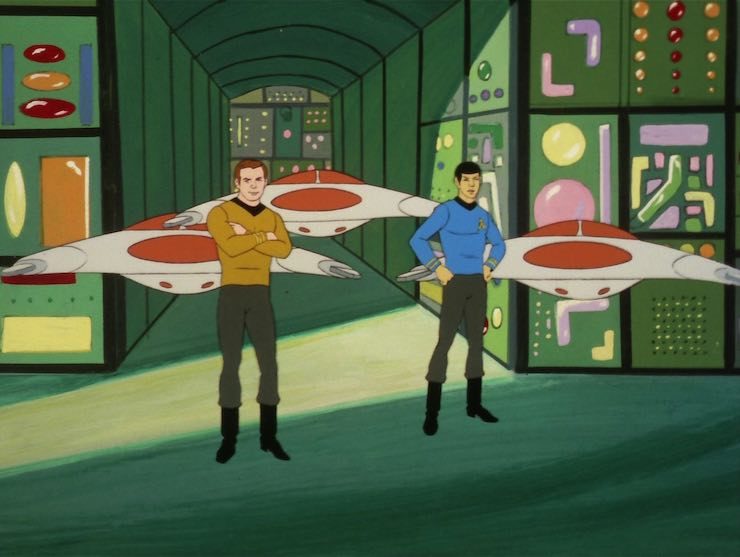
Unfortunately, it suffers from several difficulties, not the least being a similar one to that of “More Tribbles, More Troubles,” to wit, too many callbacks to the first episode without doing enough that’s different. In both this episode and “Shore Leave,” the planet drives them batty, but since they know the planet’s secret, this time it has to be a malfunction.
On top of that, the pacing in the episode is egregious. If I hadn’t known that Menville and Janson were animation writing veterans, I would have pegged them for newbies who didn’t know their way around a half-hour animated action-adventure show, because so many parts of this episode drag needlessly, from the too-long establishing shot of the planet before Sulu, McCoy, and Uhura beam down to the even-more-too-long sequences with the Enterprise malfunctions. (It doesn’t help that the episode grinds to a halt every time M’Ress speaks, since Majel Barrett has her talk so slowly that she sounds like she’s doped up on Quaaludes, plus every line of dialogue must be followed by a purr.)
Finally, while the notion of a computer that thinks that computers must be the dominant life form is a good one, and the computer’s ranting about slaves to sky machines and such is delightful, the actual rationale behind the computer’s actions is provided in the most tiresome of expository lumps, followed by the second-least convincing a computer of its illogic by Jim Kirk (surpassed only by “The Return of the Archons“). The argument provided by Kirk, Spock, and Uhura is weak and incomplete and specious and the computer just buys it because the episode is running out of time.
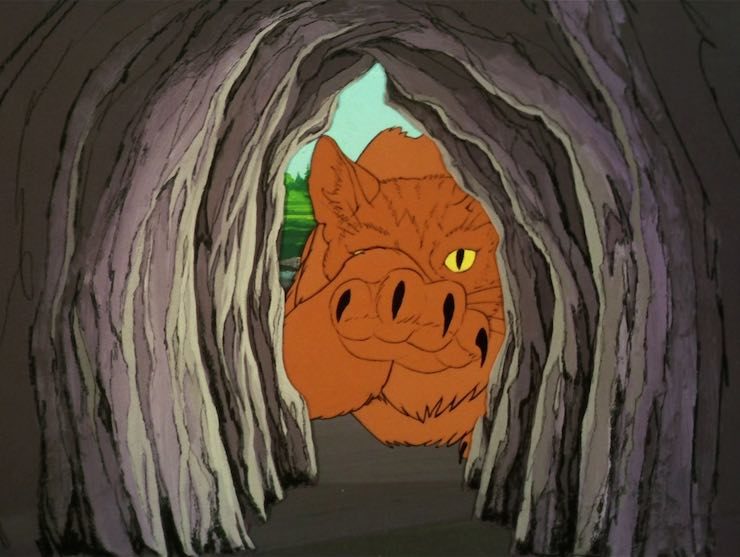
There are fun moments here—I love the pterodactyls and the much-more-convincing giant cat and the two-headed dragon, and seeing the Queen of Hearts try to behead McCoy is hilarious—but the episode doesn’t hold together nearly as well as it should. Kinda like the episode it’s a sequel to, come to think of it…
Warp factor rating: 4
Next week: “Mudd’s Passion”
Keith R.A. DeCandido will have short stories in several 2017 anthologies: Baker Street Irregulars (featuring alternative Sherlock Holmes tales) in March, Aliens: Bug Hunt in April, Nights of the Living Dead (co-edited by George Romero) in July, and both TV Land: Summer Programming and Joe Ledger: Unstoppable in October.










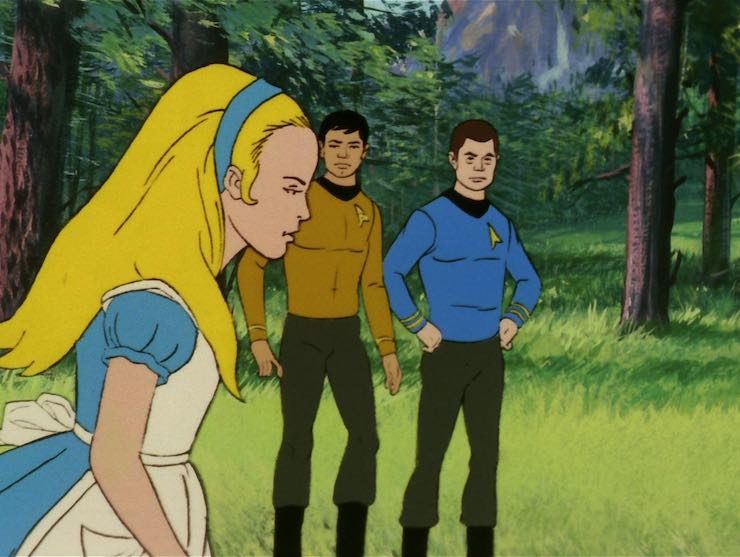
At least the splurged on the animation, it looks like – those screenshots of the two-headed dragon and the purple pterodactyls are pretty high end for Filmation.
Keith wrote:
I can’t ever hear M’Ress as an actual character. All I ever hear is Christine Chapel trying to sound SEXAAAAAY in her kittycat cosplay.
@2/MeredithP – I was 12 years old when I first saw this, and called my friend Brian, also 12, right after. First thing he said was that talking slow and adding purrs are not good traits for a comms officer (he’s really smart, he went to Harvard). After that it was hard to take M’Ress seriously.
Also, rewatching this 50-some years after it came out, it was clearly Christine Chapel’s voice. “Majel Barret cosplay” is the exact wording that came to mind. Was “cosplay” even a word in 1973? Were “furries” afoot back then?
“Was “cosplay” even a word in 1973?”
No. The word “cosplay” (kosupure) was coined in 1984 by Japanese journalist Noboyuki Takahashi, as a portmanteau abbreviation of “costume play.” He was describing a masquerade at a sci-fi convention, but the loan word “masquerade” means aristocratic costume in Japanese, so he needed to coin a different term for it. The term became popular in Japan in the ’90s, but going by a Google Ngram search, it didn’t catch on in the English-speaking world until around 2000.
“Were “furries” afoot back then?”
Wikipedia says the term was coined around 1980, but that the fandom has its roots in ’70s underground comics.
Wouldn’t Majel’s delivery of her lines be up to the director? If he thought she was saying them too slowly, wouldn’t it be part of his job to have her speed it up?
I’m not convinced Doohan does the White Rabbit. It sounds to me like the same person voicing Gabler, who may or may not be Lou Scheimer or a member of his family.
Alan Dean Foster gave Gabler the first name of Frank, which I used when I featured him in Department of Temporal Investigations: Forgotten History. I think Gabler shows up in TOS: The Face of the Unknown as well.
I think this episode is quite good. Sure, superficially it repeats a lot of beats from “Shore Leave,” but it surpasses “Shore Leave” in that it’s actually about something. In the original episode, the whole thing was a misunderstanding and nobody was in any actual danger at all, so it was all kind of pointless. Also, none of the crew really accomplishes anything; they just wander around in confusion or fear or get into gratuitous fights until the Keeper shows up and infodumps everything. Here, though, there’s a genuine source of peril, and the characters actually reason their way to a solution on their own. Plus it nicely expands on the worldbuilding of the original, in that we actually get an exploration of the mechanics of how the planet works. I think it’s the best kind of sequel, the kind that improves on its predecessor and fleshes out the potentials only hinted at before. Plus it does a great job of putting Sulu and Uhura at the heart of the action, though Uhura looks kind of ineffectual given that Kirk and Spock only needed a minute to talk down the computer she’d been arguing with for much longer.
It does have some flaws, though. Aside from the improbable ease with which Kirk and Spock change the computer’s mind, there’s another logic hole that only just occurred to me (or that I’d thought of and forgotten before): If the computer can read minds to create illusions and sense intentions, why didn’t it already know that the visiting starship crews were the masters of their “skymachines” rather than their slaves? Also, though there’s some nice artwork on the dragon and pterosaurs and the like, there are a couple of animation errors as well. The robot drones’ shadows on the floor in the computer complex are mistakenly colored to look like the drones, which confused the hell out of me for years. (Unless the floor was supposed to be shiny and reflective — but Kirk, Spock, and Uhura have neither shadows nor reflections.) The hangar bay door slides over from the starboard end rather than parting in the middle. And in a couple of shots, Sulu is seen at the helm console when we know he’s down on the planet. Given that they went to the extra trouble to add the zero-gee seatbelts, it’s surprising they didn’t catch that error.
This episode establishes a number of bits of Enterprise tech never seen before or again — bridge seat harnesses (would be handy to keep from being flung out of chairs), robot arms capable of fabrication, the rather interestingly designed phaser bore.
IMO this is a much better sequel than “More Tribbles, More Troubles”. It’s cool to see the interior of the planet, and the interior looks really good. The story makes more sense – it’s easy to imagine that something would go wrong after the planet’s keeper dies. And I disagree that this is a lame outtalking-the-computer episode. On the contrary, it’s one of the best. First, it isn’t just Kirk who does the talking, it’s a team effort. Second, they don’t convince the computer to self-destruct, they get it to see its job in a different light. They even negotiate a compromise by accepting the computer’s demand for more discussions. I like that.
I have only one complaint: Spock is wrong about Lewis Carroll. The Queen of Hearts and her cards are from Alice’s Adventures in Wonderland. Through the Looking Glass features chess pieces.
kkozoriz: Yes and no. The major issue is a byproduct of the fact that most of the time, everyone was filming their dialogue separately, so you can’t really tell how the back-and-forth of the conversations are paced until long after they’re recorded and stitched together. Barrett didn’t have anyone else to play off of when she recorded her lines, so there was no way to tell that her languid line readings would grind the dialogue to a halt.
—Keith R.A. DeCandido
@5/Jana: Oh, right. Yeah, that Lewis Carroll attribution error always bugs me.
I think the original Shore Leave was about something, though I’m not sure it was intended in the way I saw it. It shows Kirk having an extended therapy session of reconnecting with Ruth and kicking Finnegan’s butt—dealing with past trauma, bad memories and so on (who hasn’t thought of these things after a certain age?). Though again, I’m not sure if that’s what they were aiming for besides a simple fantasy episode.
Exploring how the planet works is interesting as well in this episode, but I enjoyed exploring the characters in the original more. Sulu really likes guns! Interesting.
@8/Cheerio: Okay, let’s say, rather, that this episode has more genuine stakes. Nothing seemed to have any stakes in “Shore Leave.” Not only was it all an illusion, but even when Kirk thought it was all for real, he still just forgot all about his best friend dying two minutes earlier so he could have a romp beating up his school bully.
I agree that the concept of this episode was a good one.+
But the execution… oh, boy.
First and foremost, the potential of an animated take on the “Shore Leave Planet” is criminally underuesd. They could have shown us manifestations of anything yet gave us this? Well, at least the circumstances of the appearance of the giant cat were genuinly funny (“a game of cat and mouse” indeed!).
And speaking of cats, please please tell me this is the only episode in which M’Ress purrs like that. Meredith called it “sexy”, but I think “grating and annoying and distracting and causing me a mysterious urge to throw a shoe at the screen” would be a more fitting description.
I did like the ending, though. A nice twist on the classic “Kirk talks a computer to death” only without killing the computer. Who knew Kirk was such a good salesman? I would pay a great deal to see Kirk smooth-talking to Landru/Norman/M5 and getting them to be his best pals.
4 it is.
4. ChristopherLBennett – The computer may not be able to read minds to a “mind meld” degree but something more akin to Troi’s empathy. That is, it may be able to read surface thoughts but not deeper memories. Once the subject thinks of something, no matter how briefly, the computer would be able to access it and create the duplicate. Unless someone is actively thinking “we created the ship and we are it’s master” then the computer would not be able to tell who was actually in charge.
#9
I see your point. But if my best friend had just been killed, I’d be game for beating the hell out of my school bully to get those emotions, mainly anger, out of my system. Again, it’s more Therapy Planet than Shore Leave Planet, in my opinion.
Scratch that. It’s more Screwing With Your Head Planet. ;-)
6. krad – There were a few episodes where the cast was together. I wasn’t sure if this was one of them or not.
Shatner had the same problem, without someone to play off of, he usually comes across as even more Shatneresque than usual.
Seeing as Majel didn’t have a lot of experience in voice acting, I wouldn’t hold it against her. It’s up to the director to get the proper performance of of the actors. If you just let them all go off on their own tangents, you end up with a disjointed mess. For budgetary and other reasons, Filmation decided to go with what they got for the most part. For all it’s quirky charm, this is, after all, a Saturday morning TV show with a very limited budget. As your own reviews show, it’s highly variable in it’s quality and even the best has some fairly glaring problems.
@9/CLB: I have to admit, more than one person I’ve watched “Shore Leave” with assumed that there was something affecting the crew’s minds that made them so carefree about everything that happened over the course of the episode, it was so odd how they acted.
I can’t say I don’t like that idea myself, honestly.
@11/kkozoriz: I thought of the “surface thoughts” thing, but it doesn’t work. A surface image of a character from Lewis Carroll or a medieval knight or whatever wouldn’t behave like it was supposed to unless the computer was able to read the entire conceptual, cultural, and psychological context that went with it. That’s a pretty deep web of associations and it would require a deep understanding of the culture that the images belonged to.
@12/Cheerio: I could buy that if Kirk’s attitude after beating up Finnegan hadn’t been goofy amusement. It wasn’t therapy — the episode just shrugged off the emotional impact of the “death” so that it could have an overlong and incredibly gratuitous fistfight scene.
By the way, rewatching this today, it struck me as ironic that, just after Spock cautioned that the planet could use their thoughts against them, he said “We must monitor our thoughts and give our enemy no more ammunition.” Dude! Don’t say ammunition!!! If not for Saturday morning broadcast standards, the planet might’ve thrown some Chicago mobsters with tommyguns their way a moment later.
15. ChristopherLBennett – How much cultural understanding does it take to understand “Off with his head”? If you think of the character of the Queen of Hearts, the associated context comes along with it. If you think of an elephant, you’ll also be thinking of how it moves, how it uses it’s trunk and how it sounds. Unless you can look at a picture of an elephant and simply thing “large grey animal with long nose”. you’re going to think “Elephant”.
Or, we can accept that like may other things in Star Trek, it’s best not to think too deeply on things like this. If you do, most of the stories end up with gaping plot and logic holes in them.
@@.-@ Perhaps the planet computer did read Uhura’s mind enough to know that the crew thought they were masters of the skymachine, but it was so single minded in its purpose that it just dismissed that idea because it “does not compute”, and the concept required a lot more reinforcement before the computer could finally accept it.
On the subject of machines that think they’re superior to organic life, it was interesting that the idea came here in the animated series before we saw it played out even more seriously in Star Trek: The Motion Picture. It hadn’t occurred to me until reading this rewatch where we saw it first.
richf @17- OG Star Trek did have several machines with superiority complexes- Nomad, Ruk and Andrea (and Corby-bot?), Norman and all the twinsies.
There’s probably more.
@10/OmicronThetaDeltaPhi: “I would pay a great deal to see Kirk smooth-talking to Landru/Norman/M5 and getting them to be his best pals.” – Norman and his gang were prejudiced against humans because of having met only Harry Mudd, so I assume they wouldn’t have listened. And M5 had already killed several people and was about to kill some more; also, when Kirk started talking to it, they already knew that its mind was modelled after Daystrom’s, who was obviously disturbed. In that situation, Kirk was probably glad to have found a line of reasoning that worked at all.
Now, Landru, that’s another matter… I can see that work. “Landru, you have an admirable system here, but it has some flaws. First, there’s this Red Hour where people get hurt. Then, there’s a resistance movement, so clearly some people aren’t happy. Can we help you to overcome these problems and achieve your Prime Directive even better? You shouldn’t be limited to the wisdom of only one world. We can offer you several civilisations’ philosophical works about happiness research and aid you in implementing the changes, if you want.”
@17/richf: That’s what I’m thinking too. The planet computer has contradictory data in its current belief set, and by talking to it, our guys force it to realise that and reestablish consistency.
I agree that the purrs at the end of every line by M’ress got to be quite distracting. I hadn’t noticed that in other episodes before this. Is that something she always did? Is it just that she had more lines in this episode than she usually does, so it was more noticeable?
This was a fun episode, but it could have been more fun. At least animation gave them the freedom to have a believable giant cat, Pterasaurs, and a dragon. More along the lines of what you might expect from this planet, rather than old flames and school bullies. All the same, you nailed it with the pacing, not helped at all by the aforementioned purrs.
kkozoriz @@@@@ 16 – I’m pretty sure you hit the nail on the head with your last guess.
@20/JamesP: I think this is the only epsiode where M’Ress purrs at the end of her lines. I’m not sure why they only did it here. If this had been the first M’Ress episode, it could be something they tried and dropped, but in production order, this was apparently the last episode made in season 1.
If we’re discussing sequels to TOS episodes, this is not only better than Shore Leave (which I was never the biggest fan), but it’s miles better than the Tribbles sequel. At least Kirk and crew aren’t going nuts with no information. It’s a faint praise to be sure, since the episode can drag at times, but thankfully the majority of the crew gets their share of screentime trying to do something meaningful. And faking Spock’s death was quite the smart move by McCoy.
As far as TAS entries go, I feel this is one of the better ones. It doesn’t feel as rehashed as the Tribbles episode. It actually tries to explore the concept of the planet a bit further, even if the plot doesn’t always cohere.
As for M’Ress, I stand by what I previously said. That sultry voice, and now with the added purring. Truth be told, she sounds more like a drugged up phone sex dispatcher than a starfleet officer. That animation pose really doesn’t do any favors either.
@4/Bennett: Right? I’ve been watching Star Trek for years, from TOS to Enterprise, and every time a ship/shuttle hits a piece of space dust, the entire crew gets thrown across the bridge/flight deck/galley/lift/toilet from one wall to the other. COME ON! Where’s Ralph Nader when you really need him? I can’t believe in decades of Federation starship evolution, nobody has yet thought of seat belts. Really?
Just one reason why some people disdain sci-fi so much: the lack of common-sense safety features.
Sara B: Anecdotally, Gene Roddenberry was once asked why there weren’t seatbelts on the Enterprise and his response was, “Because then they can’t fall out of their chairs.”
—Keith R.A. DeCandido
@21/Christopher: Oh, I had assumed we were watching TAS in production order. Thanks for pointing that out.
Completely unrelated – since you mentioned The Face of the Unknown in your earlier comment, are you interested in feedback? You probably get lots anyway…
@24/Sara B: On the other hand, people walk around on the ship so much that seatbelts would only protect a small proportion of them. Perhaps only the people on the bridge, minus Kirk because he likes to pace. Starships aren’t means of transportation, they’re places where people live. I can imagine that Starfleet experimented with seatbelts and came to the conclusion that the practical and the psychological disadvantages outweigh the safety gain.
Seatbelts would make sense in shuttles, though.
On a different note, seatbelts in cars were still a relatively new invention when TOS was made, so perhaps it would have seemed odd to have them.
@24,25,26 — Am now imagining the walls & ceilings of the Enterprise festooned with cables, and the crew wearing rock-climbing harnesses with carabineer clips which they’re constantly detaching and reattaching as they move through the ship.
(This also raises the somewhat related question of why they used the extra-explodey consoles that they must’ve picked up at the local Axeman.)
@27/hoopmanjh: One thing I love about Star Trek: Enterprise‘s set design is how the bridge, corridors, etc. have handrails all over so that people have something to hold onto in case the gravity plating fails. It’s a nice bit of plausible design that acknowledges the older tech being less reliable.
Unless I’m much mistaken, the Abramsverse Enterprise has safety restraints for (at least some stations on) the bridge. I feel like I specifically remember seeing Sulu in a harness. Maybe not for casual flying, but it would make sense when they were in combat.
@29/JamesP: The TMP Enterprise had seat arms that folded down to become leg restraints. It’s just one of many common-sense improvements in the movie era that were inexplicably abandoned by TNG, along with security armor and engineers’ radiation suits.
Yeah – I remember that now.
There are a bunch of elements that make a great deal of sense, but only ever appear when they’re critical to the plot. The beam-up call sign in “Whom Gods Destroy” and the subcutaneous trackers in “Patterns of Force” come to mind.
@30/Christopher: Regarding the lack of restraints on TNG, I actually wonder if the Enterprise D was originally designed to not shake at all during an attack, due to more advanced stabilizer fields or some other compensation system. During The Last Outpost, there’s a scene in which the Ferengi attack the ship using an energy blast. Other than potentially giving some crewmembers seizures due to the pretty show of flickering lights, there’s no real physical impact from the blast. Nothing shakes whatsoever. Meanwhile, Riker and Picard sit unfazed during the attack.
Of course, that’s neatly contradicted three episodes later when The Battle establishes the Battle of Maxia and how capable the Ferengi were in causing real damage to a Starfleet vessel.
Looking at the next to last screencap, I find myself wondering if the resemblance of the drones to the Martian machines (sans eyestalks) from the 1953 War of the Worlds movie was intentional…
this makes me think not of THIS episode but of Shore leave itself. Is my faulty memory or is Shore leave THE MOST beaten up Kirk EVER gets from a fist fight? Some pleasure planet!
@34/roblewmac: “So think only happy thoughts!”
In re the dragon, pterodactyls, etc.: Robert Kline, who became an important animator at Filmation and later went on to work for Disney, was a close friend of mine all through high school, after which we lost touch. Bob and I were both huge dinosaur fans, so I’d bet Bob was the lead designer behind the reptilians in this episode. There’s a killer drawing of a knight fighting a fire-breathing dragon in our 9th grade junior high school annual that Bob did…at age 14.
Alan: Thanks so much for coming in and commenting here. :)
—Keith R.A. DeCandido
Wow, Alan Dean Foster. What an honor!
I really enjoyed this episode. I think it’s better than Shore Leave (and I actually like Shore Leave, for all its faults). It’s more creative and more interesting than the episode that inspired it. Plus, while a couple of the line readings could have been edited more tightly together, most of the cast is actually very good here, even Shatner, who sounded like he was sleepwalking through the previous two episodes, and Kelley, who has never sounded good before. Yes, the ending is a bit too abrupt to be entirely convincing, but I like that Kirk reasons with the computer rather than, as is his standard practice, talking it into suicide or something similar.